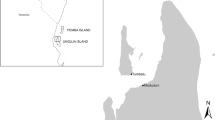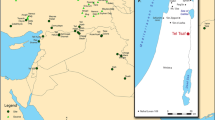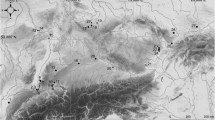Abstract
French colonial sites and French contact Native American sites in the Louisiana colony are considered in an attempt to further refine bead chronology. Research is almost to the point where bead introductions can be assigned to particular decades. Such tight dating is one of the ultimate goals of bead chronology. If this goal is reached, we can date undocumented contact period sites, or perhaps even individual features on sites of long occupation.
Similar content being viewed by others
References
Atkinson, James R. 1992 Archaeological Investigations at the Pilgrim Bayou Site, Natchez Trace Parkway, Adams County, Mississippi. Southeastern Archeological Center, National Park Service, Tallahassee, FL.
Brain, Jeffrey P. 1979 Tunica Treasure. Papers of the Peabody Museum of Archaeology and Ethnology, No. 71. Cambridge, MA.
1988 Tunica Archaeology. Papers of the Peabody Museum of Archaeology and Ethnology, No. 78. Cambridge, MA.
Brown, Ian W. 1976 Glass Beads from the Early 18th-Century Portland Site, Mississippi. Manuscript, Gulf Coast Survey, Museum of Natural History, University of Alabama, Tuscaloosa.
1978 An Archaeological Survey of the Tchula-Greenwood Bluffs Region, Mississippi. Manuscript, Cottonlandia Museum, Greenwood, MS.
1980 Early 18th Century French-Indian Culture Contact in the Yazoo Bluffs Region of the Lower Mississippi Valley. Doctoral dissertation, Department of Anthropology, Brown University. University Microfilms International, Ann Arbor, MI.
Burke, R. P. 1936 Check List—Glass Indian Trade Beads: A Descriptive Analysis of Material Found in Tallapoosa Valley of Alabama. Arrow Points, 21(5–6):53–63.
Good, Mary Elizabeth 1972 Guebert Site: An 18th-Century Historic Kaskaskia Indian Village in Randolph County, Illinois. Central States Archaeological Societies Memoir, No. 2. Wood River, IL.
Karklins, Karlis 1981 Beads from Fort Beauséjour, New Brunswick. Parks Canada, Research Bulletin 161. Ottawa, ON.
Kidd, Kenneth E., and Martha A. Kidd 1970 A Classification System for Glass Beads for the Use of Field Archaeologists. Canadian Historic Sites: Occasional Papers in Archaeology and History, 1:45–89. Ottawa, ON.
Lorenzini, Michele 1995 A Classification of Glass Trade Beads from the Bell Site (47-Wn-9), Winnebago County, Wisconsin. Fox Valley Archaeology, 24:59–79.
1996 A Classification of Glass Trade Beads from the Bell Site (47-Wn-9), Winnebago County, Wisconsin. Archaeology Laboratory, University of Wisconsin, Reports of Investigation, No. 8. Oshkosh.
Mason, Ronald J. 1986 Rock Island: Historical Indian Archaeology in the Northern Lake Michigan Basin. Midcontinental Journal of Archaeology, Special Paper, No. 6. Kent, OH.
Mitchem, Jeffrey 1991 Beads and Pendants from San Luis de Talimali: Inferences from Varying Contexts. Florida Anthropologist, 44(2–4):307–315.
Neitzel, Robert S. 1965 Archaeology of the Fatherland Site: The Grand Village of the Natchez. American Museum of Natural History, Anthropological Papers, 51(1). New York, NY.
1983 The Grand Village of the Natchez Revisited: Excavations at the Fatherland Site. Mississippi Department of Archives and History, Archaeological Report, No. 12. Jackson.
Pluckhahn, Tom 1996 Draft Report on Beads from the Tarver Site, Georgia. Southeastern Archaeological Services, Athens, GA.
Prospere, Robert 1996 Trinity School Site Bead Analysis. Manuscript, Museum of Natural History, University of Alabama, Tuscaloosa.
Quimby, George Irving 1966 Indian Culture and European Trade Goods: The Archaeology of the Historic Period in the Western Great Lakes Region. University of Wisconsin Press, Madison.
Smith, Marvin T. 1992 Glass Beads from the Council House at San Luis. In Archaeology at San Luis, Part One: The Apalachee Council House, by Gary Shapiro and Bonnie G. McEwan. Florida Archaeology, 6:107–117.
South, Stanley 1977 Method and Theory in Historical Archaeology. Academic Press, New York, NY.
Stone, Lyle M. 1974 Fort Michilimackinac, 1715–1781: An A rchaeological Perspective on the Revolutionary Frontier. Publications of the Museum, Michigan State University, East Lansing.
Waselkov, Gregory A. 1998 The Eighteenth-Century Anglo-Indian Trade in Southeastern North America. In New Faces of the Fur Trade: Selected Papers of the Seventh North American Fur Trade Conference, Halifax, Nova Scotia, 1995, Jo-Anne Fiske, Susan Sleeper Smith, and William Wicken, editors, pp. 193–222. Michigan State University Press, East Lansing.
Wittry, Warren L. 1963 The Bell Site, Wn 9: An Early Historic Fox Village. Wisconsin Archaeologist, 44(1): 1–58.
Author information
Authors and Affiliations
Rights and permissions
About this article
Cite this article
Smith, M.T. Eighteenth-century glass beads in the french colonial trade. Hist Arch 36, 55–61 (2002). https://doi.org/10.1007/BF03374338
Published:
Issue Date:
DOI: https://doi.org/10.1007/BF03374338




